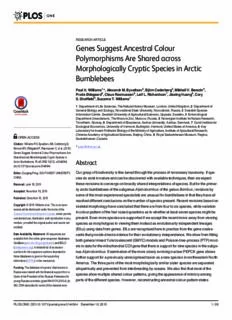
Genes Suggest Ancestral Colour Polymorphisms Are Shared across Morphologically Cryptic PDF
Preview Genes Suggest Ancestral Colour Polymorphisms Are Shared across Morphologically Cryptic
RESEARCHARTICLE Genes Suggest Ancestral Colour Polymorphisms Are Shared across Morphologically Cryptic Species in Arctic Bumblebees PaulH.Williams1*,AlexandrM.Byvaltsev2,BjörnCederberg3,MikhailV.Berezin4, FrodeØdegaard5,ClausRasmussen6,LeifL.Richardson7,JiaxingHuang8,Cory S.Sheffield9,SuzanneT.Williams1 1 DepartmentofLifeSciences,TheNaturalHistoryMuseum,London,UnitedKingdom,2 Departmentof GeneralBiologyandEcology,NovosibirskStateUniversity,Novosibirsk,Russia,3 SwedishSpecies InformationCentre,SwedishUniversityofAgriculturalSciences,Uppsala,Sweden,4 Entomological Department(Insectarium),TheMoscowZoo,Moscow,Russia,5 NorwegianInstituteforNatureResearch, Trondheim,Norway,6 DepartmentofBioscience,AarhusUniversity,Aarhus,Denmark,7 GundInstitutefor EcologicalEconomics,UniversityofVermont,Burlington,Vermont,UnitedStatesofAmerica,8 Key LaboratoryforInsect-PollinatorBiologyoftheMinistryofAgriculture,InstituteofApiculturalResearch, ChineseAcademyofAgriculturalSciences,Beijing,China,9 RoyalSaskatchewanMuseum,Regina, OPENACCESS Saskatchewan,Canada Citation:WilliamsPH,ByvaltsevAM,CederbergB, *[email protected] BerezinMV,ØdegaardF,RasmussenC,etal.(2015) GenesSuggestAncestralColourPolymorphismsAre SharedacrossMorphologicallyCrypticSpeciesin ArcticBumblebees.PLoSONE10(12):e0144544. Abstract doi:10.1371/journal.pone.0144544 Editor:ZuogangPeng,SOUTHWESTUNIVERSITY, Ourgraspofbiodiversityisfine-tunedthroughtheprocessofrevisionarytaxonomy.Ifspe- CHINA ciesdoexistinnatureandcanbediscoveredwithavailabletechniques,thenweexpect Received:June18,2015 theserevisionstoconvergeonbroadlysharedinterpretationsofspecies.Butfortheprimar- ilyarcticbumblebeesofthesubgenusAlpinobombusofthegenusBombus,revisionsby Accepted:November19,2015 someofthemostexperiencedspecialistsareunusualforbumblebeesinthattheyhaveall Published:December10,2015 reacheddifferentconclusionsonthenumberofspeciespresent.Recentrevisionsbasedon Copyright:©2015Williamsetal.Thisisanopen skeletalmorphologyhaveconcludedthattherearefromfourtosixspecies,whilevariation accessarticledistributedunderthetermsofthe incolourpatternofthehairraisedquestionsastowhetheratleastsevenspeciesmightbe CreativeCommonsAttributionLicense,whichpermits unrestricteduse,distribution,andreproductioninany present.Evenmorespeciesaresupportedifweaccepttherecentmoveawayfromviewing medium,providedtheoriginalauthorandsourceare speciesasmorphotypestoviewingtheminsteadasevolutionarilyindependentlineages credited. (EILs)usingdatafromgenes.EILsarerecognisedhereinpracticefromthegenecoales- DataAvailabilityStatement:Allsequencesare centsthatprovidedirectevidencefortheirevolutionaryindependence.Weshowfromfitting availablefromtheonlinegene-sequencedatabases: bothgeneralmixedYule/coalescent(GMYC)modelsandPoisson-tree-process(PTP)mod- GenBank(ncbi.nlm.nih.gov/genbank/)andBOLD elstodataforthemitochondrialCOIgenethatthereissupportforninespeciesinthesubge- (boldsystems.org).Adetailedlistofaccession numbersforthesequencenumbersdepositedin nusAlpinobombus.ExaminationofthemoreslowlyevolvingnuclearPEPCKgeneshows thesedatabasesisgiveninthesupporting furthersupportforapreviouslyunrecognisedtaxonasanewspeciesinnorthwesternNorth information(S2File)inthemanuscript. America.Thethreepairsofthemostmorphologicallysimilarsisterspeciesareseparated Funding:Thedatabaseofspecies’distributionsin allopatricallyandpreventedfrominterbreedingbyoceans.Wealsofindthatmostofthe Russiawascreatedwiththefinancialsupportfroma speciesshowmultiplesharedcolourpatterns,givingtheappearanceofmimicryamong GrantofthePresidentoftheRussianFederationfor youngRussianscientists(grantMK-6176.2015.4)(to partsofthedifferentspecies.However,reconstructingancestralcolour-patternstates AB).DNAbarcodesforsomeofthematerialwere PLOSONE|DOI:10.1371/journal.pone.0144544 December10,2015 1/26 CrypticArcticDiversity fundedbytheSaskatchewanMinistryofAgriculture showsthatspeciationislikelytohavecutacrosswidespreadancestralpolymorphisms, andtheCanada-SaskatchewanGrowingForward2 withoutorlargelywithoutconvergence.IntheparticularcaseofAlpinobombus,morphologi- bi-lateralagreement(grant20130112)(toCS).Work cal,colour-pattern,andgeneticgroupsshowlittleagreement,whichmayhelptoexplainthe inGreenlandwassupportedbytheCarlsberg Foundation(grants2009-01-0534and2011-01-0463) lackofagreementamongprevioustaxonomicrevisions. (toCR).DNAbarcodesforsomeoftheNorwegian materialwerefundedbytheResearchCouncilof Norway(grant266134/F50)andtheNorwegian BiodiversityInformationCentre(grant70184209). TheNorwegianpartoftheprojectwasfundedbythe Introduction TaxonomyInitiativeoftheNorwegianBiodiversity Recentlyauthorshavesoughttoreducesubjectivityinthepracticeofspeciesdiscoveryor InformationCentre(grant70184228)(toFO).DNA sequencingforsomeofthematerialwasfundedby ‘delimitation’[1]bycomparingtheresultsfromapplyingmultiplecriteriainanexplicitlyinte- theAgriculturalScienceandTechnologyInnovation grativetaxonomy[2].Thisisasearchforcongruentresultsfrommultiplecriteriaascorrobora- Program,China(grantCAAS-ASTIP-2015-IAR)(to tion,eventhoughthedifferentsetsofcharactersemployed(fromdifferentdisciplines)may JH).Partofthedatabaseofspecies’distributionsin havedifferentevolutionaryconstraintsrequiringdifferentevolutionaryexplanations[2]. NorthAmericawascreatedwithfinancialsupport Indeed,notallstudiesusingdifferentcriteriacanbeexpectedtoagree,becauserelationships fromgrantsfromtheNationalScienceFoundationto JohnAscher,DouglasYanega,andJeromeRozen betweencriteriaandspeciationeventsdiffer[1,3,4].Ithasevenbeenacknowledgedthatthose (grantsNSF-DBI0956388andNSF-DBI0956340)(to criteriathatrelatemostcloselytospeciationcouldformaminoritypatterninsomecases[2]. LR).Thefundingagencieshadnoroleinthestudy Butforsomearcticbumblebees,taxonomicrevisionsbyexperiencedspecialistshaveshown design,datacollectionandanalysis,decisionto unusuallypooragreementonthenumberofspecies,wesuggestinpartbecauseofpooragree- publish,orpreparationofthemanuscript.Theother mentamongresultsfromapplyingdifferentcriteria. authorsreceivednospecificfundingforthiswork. Bumblebees(genusBombusLatreille)havebeendescribedasmorphologicallyhomoge- CompetingInterests:Theauthorshavethe neouscomparedwithotherbees[5].Itisthereforeunsurprisingthatbumblebeespecieswere followinginterests:workinGreenlandwassupported diagnosedinitiallyintermsofthestrikingcolourpatternsofthehaironthedorsumofthe bytheCarlsbergFoundation(grants2009-01-0534 body[6].Butthen,morethanacenturyago,itwasrealisedthatthegroupssupportedbyskele- and2011-01-0463).Therearenopatents,productsin developmentormarketedproductstodeclare.This talmorphologyareactuallymoreclearlycircumscribed,andthatwithinthesemorphological doesnotaltertheauthors'adherencetoallthePLOS species,bumblebeesarehighlyvariableincolourpatterns[7–10].Thisissupportedbyrecent ONEpoliciesonsharingdataandmaterials,as geneticstudies[11–14],reaffirmingthelong-heldviewthatbumblebeecolourpatternsdonot detailedonlineintheguideforauthors. necessarilydiagnosespecies[15].Detailedstudiesofbumblebeevariationhaveledtothereali- sationthatspeciescanbecrypticinbothmorphologyandcolourpattern[16,17],nowcon- firmedbygeneticstudies[18,19]. Particularlyintriguingistheobservationthatbumblebeecolourpatternsareoftenimpres- sivelysimilaramongspecies[8,20–26].Inmanycases,asinglespeciesmayshowdifferentcol- ourpatternsindifferentgeographicalregions,ineachofwhichtheymayresembleclosely otherspeciesasmembersofregionalcolour-patterngroups[24,27].Severalpossibleexplana- tionshavebeenproposed(reviewedin[26,28]),includingMüllerianmimicry[22,29].Recent advancesinunderstandingevolutionaryrelationshipshavebeguntoclarifythechronologyof theevolutionofsomeoftheseresemblances[30],animportantpre-requisitetodiscerning causes[31].Incasesofregionalcolour-patternresemblance,thesimilarspeciesareoftenonly distantlyrelated,sothatthesimilarityhasbeeninterpretedastheresultofevolutionaryconver- gence[26].Weexploreanotherpossibleexplanationfortheevolutionofcolour-patternresem- blance,asanalternativetoconvergence:thatinsomesituationsapolymorphismwithinan ancestralspeciesmayhavebeeninheritedinparallelbyseveraldescendentspecies. ThebumblebeesofthesubgenusAlpinobombusSkorikovareasmallgroupofcloselyrelated species[32].Previoustaxonomicrevisions(includingglobalrevisionsandbroaderregional faunalrevisionswithglobalreferencing)ofAlpinobombusbysomeofthemostexperienced bumblebeespecialistshavereliedonbothmorphology(especiallythemorevariablecharacters ofthemalepenisvalve,volsellaandgonostylus,andofthefemaleoculo-malarareaandhind tibia)andonthecolourpatternsofthehairandhavealldifferedintheirconclusionsonthe numberofspeciespresent(Table1).Severalrecentfaunallistshaveacceptedasvalidjustthe PLOSONE|DOI:10.1371/journal.pone.0144544 December10,2015 2/26 CrypticArcticDiversity fivemoreclearlymorphologically-diagnosablespecies(interpretedinabroadsense,fromthe shapeofthefemalehead,malegenitalia,etc.):B.alpinus,B.polaris,B.balteatus,B.neoboreus, andB.hyperboreus[10,33–35].Butvariationincolourpatternpromptedsomeauthorsto questionwhetheratleasttwomorespeciesmightbeaddedtothislist:B.pyrrhopygus(but usingthejuniorsynonymsB.diabolicusFrieseandB.alpiniformisRichardsforbeeswiththe Scandinaviancolourpatternofthisspecies)andB.kirbiellus,eventhoughbothlackedclearly discretediagnosticmorphologicalcharacters[36–38].ThecolourpatternsofAlpinobombus specieshavebeendescribedasbeingbothvariablewithinspecieswhileshowingclosesimilari- tiesamongspecies[36,37,39–43].Thesespeciesareunusualevenamongbumblebees[10,44] foroccupyingextremearcticoralpinehabitats[40,43,45].Therefore,atleastinthefarnorth, theyco-occurwithfewornootherbumblebeespecies[36,37,43,46],whichsimplifiesthesys- temforanalysisifmimicrywereinvolved. WeusesequencesforpartsoftheCOIandPEPCKgenesfromfreshlycollectedspecimens andfrommuseumspecimenstorecognisetheevolutionarilyindependentlineagesofthesub- genusAlpinobombusasspeciesandtoestimatethephylogeneticrelationshipsamongthese species.Wethentestwhetherthecolour-patternpolymorphismsaremorelikelyeithertobe ancestral,ortohavearisenmorerecentlyandconvergentlywithinthedaughterspecies.From ouranalysesweconclude:(1)thatcoalescentsfortheCOIgenesupportnearlytwiceasmany species(ninecf.five)ashavebeenrecognisedfromskeletalmorphologyandthatthreeofthese species,includingonetaxonnotrecognisedpreviously,arealsosupportedbyPEPCKpolymor- phisms;and(2)thatsimilarityincolourpatternamongpartsofthesespeciesislikelytohave arisenfrombroadlyconservedancestralpolymorphisms,notfromconvergence.Thework reportedherebuildsonasurveyofthemorphologyandcolourpatternsoftheNorthAmerican Alpinobombus[42]andispartofarevisionarystudyofAlpinobombusbumblebeesworld-wide, whichwilltreattypespecimensandnomenclaturalissuesseparately. Table1. ListsandnumbersofSpeciesoftheSubgenusAlpinobombusfromprevioustaxonomicrevisions.a Richards1931[39] Skorikov1937[43] Milliron1973[36] Løken1973[37] Thisstudy alpinus alpinus alpinus alpinus alpinus pyrrhopygus arcticus arcticus polaris arcticus polaris kincaidii kincaidi balteatus balteatus balteatus balteatus balteatus tristis kirbyellus kirbiellus neoboreus neoboreus ? neoboreus strenuus strenuus strenuus ? unnamed natvigi hyperboreus hyperboreus hyperboreus hyperboreus hyperboreus Total 7 8 6 4 9 Splitb 2 3 0 0 - Lumpedb 3 3 2 3 - aSpeciesnamesandspellingsarethoseusedintheoriginalpublications.TherevisionbyLøkendidnotcovertheNewWorldfaunaandsodidnottreatB. neoboreus/B.strenuus. bCountsofsplitandlumpedspeciescomparedtothisstudyexcludethe‘unnamed’taxonthatwetreat(conservatively)asunsampledpreviously. Authorsofthetaxonnames:alpinus(Linnaeus),arcticusKirby,balteatusDahlbom,hyperboreusSchönherr,kincaidiiCockerell,kirbiellusDahlbom,natvigi Richards,neoboreusSladen,polarisCurtis,pyrrhopygusFriese,strenuusCresson,tristisFriese. doi:10.1371/journal.pone.0144544.t001 PLOSONE|DOI:10.1371/journal.pone.0144544 December10,2015 3/26 CrypticArcticDiversity MaterialsandMethods Ethicsstatement Nohumansorvertebrateanimalswereusedinthisresearch.Fieldpermits:(Russia)Bumblebees ofthesubgenusAlpinobombusarenotincludedinanyRedListsandarenotlistedunderthelaw ‘Onenvironmentalprotection’inRussia.Noneoftheareaswherefieldworkwascarriedoutare private.OnlyMeduzaBayinWestTaimyrisapartoftheGreatArcticReserve,wherethe researchwasconductedwiththepermissionoftheReservemanagement.Specimensfromthe researchcollectionofNovosibirskpassedtheStateveterinarycontrolbeforeexportonloan. (Norway)NopermitswereneededforcollectingoftheNorwegiandata. (Sweden)NoneofthebeeswerecollectedwithinNationalParksorNatureReserves.They arenotsubjecttoanycollectionrestrictionsandthereforepermitsarenotrequired.Atpresent thereisnolegislationorrestrictionsthatregulatestheexportofgeneticsamplesfromSweden. ThereisnootherrestrictiononthetransferofscientificmaterialofthissortbetweenEUmem- berstates. (Denmark/Greenland)TheGreenlandEcosystemMonitoringCoordinationGroupatthe NationalEnvironmentalResearchInstitute,AarhusUniversity,approvedourresearchpropos- alsforaccessandresearchactivitiesinboth2010and2011. (Canada)Nopermitswererequiredforcollectionsitesvisited. (USA)CollectionsfromtheRockyMountainBiologicalLaboratoryinColoradoweremade accordingtoanagreementbetweentheRMBLandtheUnitedStatesForestService. WebringtogethersamplesoftaxaofthesubgenusAlpinobombusfromthroughouttheir globaldistributions.Taxonomicandgeographicalbreadthisessentialinataxonomicrevision forachievingarepresentativesampleinordertoassessthefullrangeofpatternsofvariation andrelationship[47,48].Thisisespeciallyimportantforreducingthebiasthatmightother- wiseresultifsamplingwererestrictedtojustoneortwoisolatedregionsorweretoexclude majorlineages.Tocoverallvariation,wemadeapreliminarysurveyofspecimensfrom museumcollections(Fig1;seethesupportinginformation). TorecognizespeciesofthesubgenusAlpinobombus,weacceptthebroadlyheldconceptof speciesasevolutionarilyindependentlineages(EILs)[1].Torecognizethesespeciesinpractice, weusestatisticaltestsdesignedtoidentifygenecoalescents,whichprovidedirectevidencefor EILs[49].Coalescencemethodsaresuggestedtobeespeciallyusefulcomparedtolessdirect indicators(includingcriteriarelatedtomaterecognitionandreproductiveisolation)because theycandetectlineageseparationeveninitsearlystages[1,3].Weuseoneofthefastestevolv- ing,mosthighlyvariablemitochondrialgenes,codingforCOI(cytochromeoxidasesubunitI). Thisisparticularlyappropriatefordetectingspeciesbecauseofitsrapidcoalescencewithinlin- eages[3,50].Fromamongrecentlycollectedspecimensshowingthemostobviousmorpholog- icalandcolourvariation,wesequencedthe‘barcode’regionoftheCOIgene(Fig1). Mostoftheextraction,amplification,andsequencingworkwasdoneattheBiodiversity InstituteofOntario,Guelph,usingstandardprotocols[51]andprimers[52].Aminorityof specimenswereprocessedattheInstituteofApiculturalResearch,Beijing.Becausethegeo- graphicrangeoccupiedbyAlpinobombusislargeandmanyareasaredifficulttoaccess,mito- chondrialDNAwithmanycopiespercellhastheadvantageofbeingmoreeasilyextracted,so thatevenpinnedmuseumspecimenscanbesampled.Although70%ofAlpinobombusspeci- menssurveyedareknowntobelessthanacenturyold,only8.6%arelessthan10yearsold.A problemwitholdermuseumspecimensisthatthesequencesobtainedareoftennotoffull length[53].SequencealignmentsweremadeusingtheClustalWfunctioninMEGA(version 6.06,accessed2014:megasoftware.net[54])andaminoacidtranslationswerecheckedwith EMBOSSTranseq(accessed2014:ebi.ac.uk/Tools/st/emboss_transeq/). PLOSONE|DOI:10.1371/journal.pone.0144544 December10,2015 4/26 CrypticArcticDiversity Fig1.GlobalSamplingoftheSubgenusAlpinobombus.Greyspotsshowsamplesitesforthe4345 specimensexamined(Alpinobombusspeciesareunknownfromthetropicsorfromthesouthern hemisphere;collectionslistedinTableAinS1File);blackspotsshowthesitesforthe173sampleswithCOI barcodes;andquestionmarksshowthesitesfordoubtfulrecords(specimenssupposedlyfromsitesthat combinelowlatitudewithlowelevation).Polarprojection,NorthPole(starred)atthecentreofthemap. TerrestrialnationalboundariesandtheArcticCircleareshownasnarrowgreylines.ImagecreatedinArcGIS usingWorld_Shaded_ReliefbasemapwhichisCopyright2014ESRI. doi:10.1371/journal.pone.0144544.g001 Tocheckforpossiblemismatchesbetweentreesfordifferentgenes,andhenceforpossible mismatchesbetweengenetreesandspeciestrees[49,55],wealsosequencedthenucleargene PEPCK(phosphoenolpyruvatecarboxykinase;accessionnumbersforsequenceslistedin TableAinS2File,obtainedusingprimersfrom[32]).Thisgenehasbeenpopularforstudies ofbumblebees[11,30,32]. Torecognisespecies,single-thresholdgeneralmixedYule/coalescent(GMYC)modelsseek atransitionexpectedinthetree-branchingratesbetweeninterspecificbranchesandintraspe- cificbranches[56–61].GMYCanalysisrequiresanultrametricestimateofthephylogenetic treethatincludesonlyuniquehaplotypes[59,62](T.Barraclough,pers.comm.)inorderto avoidspuriousinflationofestimatesofterminalbranchingrates.Aftersortingthesequences bydecreasinglength,thelongestexamplesofeachuniquehaplotypearerecognisedusingCol- lapse(version1.2,accessed2011:softpedia.com/get/Science-CAD/Collapse.shtml),which ignoressiteswithmissingdata.Asoutgroupsforrootingthetreewiththisfastgene,weinclude speciesfromcloselyrelatedbumblebeesubgenera[32]:B.(Cullumanobombus)rufocinctus Cresson,B.(Pyrobombus)vagansSmith,B.(Bombus)ignitusSmith,B.(Bombus)terrestris (Linnaeus),andB.(Bombus)cryptarum(Fabricius).Thebestnucleotide-substitutionmodel forCOIaccordingtotheBayesianinformationcriterion(BIC)obtainedfromMEGAisthe generaltime-reversiblemodelwithagamma-frequencydistributionofchangesamongsites (GTR+Γ).BEAST(version1.8.0,accessed2013:beast.bio.ed.ac.uk)wasusedforBayesiananal- ysisofmultiplemodeltrees[63].Theclockmodelwassettotheuncorrelatedlognormal (relaxedclock),thetree-speciationpriorwassettoaconstant-sizecoalescentprocess(consis- tentwiththenullhypothesisthatthereisasinglespeciesinthedata),andthechainlengthfor theMarkov-chainMonteCarlo(MCMC)algorithmwassettotwobilliongenerations,with samplingofthetreesevery200,000generations.ThesampleofresultingtreesfromtheMCMC PLOSONE|DOI:10.1371/journal.pone.0144544 December10,2015 5/26 CrypticArcticDiversity algorithmwasexaminedusingTracer(version1.6.0,accessed2013[63]),whichshowedthat stationarityhadbeenachievedwithinthefirst1%ofthetotalMCMCgenerations.Thelarge numberofMCMCgenerationswasneededwithourdatatoincreaseeffectivesamplesizes.A maximumclade-credibilitytreewasobtainedfromthepostburn-intreesampleafterrejecting thefirst1%ofsampledtreesusingTreeAnnotator(version1.8.0,asforBEAST).Afterremoval oftheoutgroups,theGMYCmodelwasappliedtothetreeusingtheSPLITSlibrary(version 1.0–11,accessed2011:r-forge.r-project.org/projects/splits/)runningontheRplatform(ver- sion2.12.1,accessed2011:www.r-project.org).Theoldestavailablename[64]isappliedto eachcoalescentgroupasaprospectivespecies.Multiplerunsofallanalysesweremadeandthe stabilityoftheresultschecked. TochecktherobustnessoftheGMYCresultsbytakingintoaccounttheuncertaintyinesti- matesofphylogeny,weappliedaBayesianGMYCanalysis[59]usingthebGMYClibrary(ver- sion1.0.2,accessed2015:sites.google.com/site/noahmreid/home/software)ontheRplatform. bGMYCwasappliedtothelast100treesfromthesampleof10,000treesfromtheBEASTrun oftwobillionMCMCgenerations(asamplerepresentingthelast20milliontrees)thathad beencheckedpreviouslywithTracerforstationarity.bGMYCwasrunwiththedefaultsettings (MCMC50,000generations,burn-in40,000,thinning100). Asanothercheckonthenumberofspeciesrecognised,weapplyanotherrelatedapproach fordiscoveringspeciesdesignedforusewithsingle-locusdata,lookingforchangesinthenum- bersofnucleotidechangesalongbranchesfrombetween-towithin-speciesrelationships, basedonPoisson-treeprocesses(PTP:[65]).PTPanalysisislessdemandingoftreeinforma- tionthantheGMYCapproachandthereissomeevidencethatitcanperformbetter[65].We applytheBayesianimplementationonthebPTPserver(accessed2015:species.h-its.org)toa metricmaximum-clade-credibilitytreefromCOIbarcodesobtainedwithMrBayes(version 3.1.2,accessed2011:[66]),usingthesamedata,outgroups,andnucleotide-substitutionmodel, fourchains(temperature0.2),and100milliongenerationsoftheMCMCalgorithmwitha1% burn-inselectedusingTracer.WeusedthedefaultbPTPoptionsafterremovingoutgroups fromtherootedtree. ThevariationincolourpatternsforthesubgenusAlpinobombusincludesmanysubtledif- ferences[42],whicharesimilarinthetwosexes.Inallcasescolourpatternsrefertothecolour ofthehaironvariousbodyregions,nottothecolourofthebodysurface,whichisbrownor nearlyblackthroughout.Generally,weobservethatthepresenceofnon-blackhaironthedif- ferentbodysegmentsisnotindependent,butappearstobeconditionallydependentamong segments[8](e.g.therearenoAlpinobombusbeeswiththehaironmetasomaltergum2black andontergum3yellow,orontergum4orangeandontergum5black,althoughinbothcases thereverseconditionsarecommon).Thereforeitshouldbereasonabletobeginbycoding bumblebeecolourpatternsforthepresenceorabsenceofareasofpalehairandthenlateradd- ingcharactersasmodifiersfortheextentofthepalehair[26,67].Asafirstapproximation,we assumethatAlpinobombuscolourpatternscanbereducedtoarepresentationastwoprincipal characters,eachwithtwostates.Character(1):whethertherearetransverseyellowbandsin thehaironthebody,usuallyanteriorlyandoftenposteriorlyonthethoracicdorsumand/oron metasomalterga1–2(stateB,banded:minimallywithanobviousyellowbandonmetasomal tergum2,varyingfrompalestrawyellowtodarkerorangebrown),orwhetherthehairinthese areasisblackornearlyblack(stateU,unbanded).Character(2):whetherthereisobviouspale hair(mostoftenredororange,butsometimesyelloworwhite)onthe‘tail’,consistingofmeta- somalterga4–6(stateP,pale:minimallycoveringtergum5or6),orwhetherthehairofthetail isblackornearlyblack(stateD,dark).Themostwidespreadcolourpatternbothamongall bumblebees[26]andamongthesister-grouptothesubgenusAlpinobombus,thesubgenus Bombussensustricto[19],hasboththeyellowbandsandapaletail.Replacementofthepale PLOSONE|DOI:10.1371/journal.pone.0144544 December10,2015 6/26 CrypticArcticDiversity bandsandthepaletailwithblackcanalsobepolymorphicwithinsomeBombuss.str.species, althoughthisisrelativelyrare(occurringin3/17and1/17speciesforthetwocharactersrespec- tively).Colourcharacterswerescoredforasampleof1646Alpinobombusspecimensofboth sexesfromacrossthedistributionrange.Toreconstructthehistoryofcolour-patterncharac- ters,weestimatethespeciestreeusingBEASTlinkedtreesfromCOIandPEPCKexonand intronsequences.Thebest(unlinked)nucleotide-substitutionmodelsaccordingtotheMEGA BICareHKYforboththePEPCKexonandintrons,thetree-speciationpriorwassettoa birth-deathprocessappropriateforamulti-speciestree,andfromexaminationoftheresults withTracer,theMCMCalgorithmwassettorunfor1.5billiongenerations.Outgroupsand othersettingswereasforthefirstanalysis.NofossilsofAlpinobombusspeciesareknownfor datingpartsofthetree,sothephylogenywascalibratedwithadatefromamolecularstudy: Hines[68]estimatedtheageofdivergencebetweenthesubgenusAlpinobombusandthesubge- nusBombuss.str.tobe13Ma.Mesquite(version3.02,accessed2015:mesquiteproject.org [69])wasusedtoreconstructancestralcharactersstatesonthistree.Weusedparsimonyanaly- sisbecausewewantedtoretaininformationonalternativeexplanationsratherthanjustthe mostlikely.Wecodedpolymorphicpopulationsasathirdintermediateorderedstate,allowing statechangesineitherdirection([70];W.Maddison,pers.comm.). Results Wefound46uniquehaplotypesamong173COI-barcodesamplesofthesubgenusAlpinobom- bus(accessionnumberslistedinTableAinS2File).TheseCOIdataareinformationrich,with 92/658nucleotidesitesphylogeneticallyinformative.TheGMYCmodelsshowasignificant changeinbranchingratethroughtimeintheCOIbarcodetree(likelihoodratio14.03between theGMYCmultiple-speciesmodelandthenullmodelthatthereisasinglespeciesinthe group,p=0.0028).Thisthreshold(at-0.0041substitutionspernucleotide)leadsustorecog- niseninecandidatesforprospectivespecies(witha95%confidenceintervalof8–11species) withinAlpinobombusasinFig2,whichalsoshowsthateachofthesespeciesisstronglysup- portedasamonophyleticgroup. ThebGMYCanalysisshowedstationarityandahighmodalcoalescent/Yuleratioconsistent withsuccess.TheposteriorprobabilitydistributionisshownagainstthefirstsampletreeinFig3 toprovidea‘heat’mapoftheprobabilitiesthatthehaplotypesareconspecific.Adoptingathresh- oldprobabilityof0.5fromtheposteriormeanfromtheanalysis(correspondingtoamoderate position,midwaybetweena‘splitter’anda‘lumper’)recognisesninespecieswithinthesubgenus Alpinobombusonthediagonal(unsurprisingly,thespecieswithmorehaplotypeshavemorestruc- turewithinthem).ThesearethesameninespeciesasareidentifiedintheGMYCanalysisinFig2. TheBayesianPTPsolutionwiththemostsupport(Fig4)recognisesthesamenineprospec- tivespecies(witharangeof7–30species),althoughtheindividualBayesiansupportvaluesfor thespeciesarenothigh(0.48–0.79). Asexpected,wefoundmuchlessvariationinthePEPCKgeneamongspeciesofthesubge- nusAlpinobombus.Only4/903nucleotidesitesinoursequencesareuniquelydiagnosticfor species,withuniquePEPCKnucleotidechangessupportingthespeciesB.alpinus(baseposi- tion351),B.neoboreus(bp755),andtwofortheunnamedspecies(bp360,533)(Table2). AdditionalPEPCKnucleotidedifferencesgivefurthersupportforthedistinctionbetweenthe speciespairB.neoboreus/unnamed(bp769).TheestimateofphylogenyforAlpinobombus speciesfromthecombinedgenedataisshowninFig5.Thisshowsstrongsupportforall groupsexceptforthepositionofB.alpinus,whichremainsuncertain. TheprincipalcolourpatternsrecordedforthesubgenusAlpinobombusshowthreeofthe fourpossiblecombinationsofthetwostatesforthetwocharacterswesurvey(Table3,Fig6): PLOSONE|DOI:10.1371/journal.pone.0144544 December10,2015 7/26 CrypticArcticDiversity Fig2.RecognisingSpeciesoftheSubgenusAlpinobombuswithGMYC.The173sequencesreducedto46uniqueCOI-barcodehaplotypesona BEASTultrametricgenetree(outgroupsnotshown).Thesinglethreshold(T=-0.0041)fromtheGMYCmodelisshownbytheverticalgreybarandthe intersectinglineagesareinterpretedassubtendingnineprospectivespecies(blackspotsshowthecoalescentnodeforeachspecies).Thetreeisthe Bayesianultrametricmaximum-clade-credibilitytreefromasampleoftreesafter1%burn-infrom2billiongenerationsoftheMCMCalgorithminBEAST. ValuesnexttothenodesareBayesianposteriorprobabilitiesshowingbranchsupport.Eachhaplotypeisrepresentedbyoneofthelongestsample sequences,labelledwithaspeciesname,acodethatconsistsofanidentifierfromtheprojectdatabaseand(afterthehyphen)fromtheBOLDdatabase, followedbyitsgeographicorigin. doi:10.1371/journal.pone.0144544.g002 PLOSONE|DOI:10.1371/journal.pone.0144544 December10,2015 8/26 CrypticArcticDiversity Fig3.RecognisingSpeciesoftheSubgenusAlpinobombuswithBayesianGMYC.The173sequencesreducedto46uniqueCOI-barcodehaplotypes ononeBEASTultrametricgenetree(outgroupsnotshown).Theposteriorprobabilitydistribution(right,colourscalefarright)isplottedagainstasampletree fromBEAST(left)toprovidea‘heat’mapoftheprobabilitiesthathaplotypesareconspecificbybGMYC.Blackspotsshowthecoalescentnodeforeach speciesfromFig2. doi:10.1371/journal.pone.0144544.g003 UP,unbandedpaletails;BP,bandedpaletails,andBD,bandeddarktails.Thefourthstate, entirelyblack(UD),isnotrecordedhere,althoughonespecimenofB.balteatusfromKara- ginskiyIsland(Kamchatka,Russia)comesclose,withonlyanarrowandincompleteyellow bandonmetasomaltergum2.Fig7showsthedistributionsofthethreeprincipalcolourpat- terns.TheUPcolourpatternisthemostrestrictedgeographicallyandisconcentratedprimar- ilyinEurope;UPalsooccursinisolatedpocketsinRussiaandinNorthAmericabutis unrecordedfromGreenland.Incontrast,theBPandBDpatternsco-occurbroadly,bothtaxo- nomically(Table3)andgeographically(Fig7).ThefrequencyoftheBDcolourpatternrelative toBPcolourpatternmayincreasetowardsthenorth(Fig7).Nonetheless,thethreeprincipal colour-patterngroupsareeachsharedbythreeofthenineprospectivespecies(Table3;B. PLOSONE|DOI:10.1371/journal.pone.0144544 December10,2015 9/26 CrypticArcticDiversity Fig4.RecognisingSpeciesoftheSubgenusAlpinobombuswithBayesianPTP.The46uniqueCOI-barcodehaplotypesasinFig2onaMrBayes metricgenetreewiththeBayesianPTPsolutionwithhighestsupport,showingnineprospectivespecies(blackspotsshowthecoalescentnodeforeach species;outgroupsnotshown).Thetreeisthemaximum-clade-credibilitytreeafter1%burn-infrom100milliongenerationsoftheMCMCalgorithmin MrBayes.ValuesabovethenodesarePTPBayesiansupportvaluesthatalldaughterhaplotypesbelongtoasinglespeciespopulation;valuesbelowthe nodesareBayesianposteriorprobabilitiesshowingbranchsupport.HaplotypeselectionandlabelsasinFig2.Thescalebarforbranchlengthsshows0.02 substitutionsperbaseposition. doi:10.1371/journal.pone.0144544.g004 pyrrhopygus,B.polaris,andB.balteatus),aswellasbeingrecordedfromboththeOldWorld andNewWorldregions,aswidespreadpolymorphisms.Whilethereareoftensmalldifferences betweenthemostfrequentpatternsforeachspecies,nonethelessinallcasesitispossibleto findspecimensthatresembleotherspeciessocloselythatdiagnosisbycolourpatternisnot alwayspossible. PLOSONE|DOI:10.1371/journal.pone.0144544 December10,2015 10/26
Description: